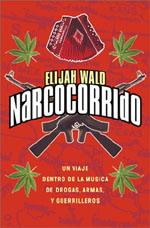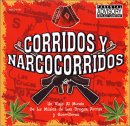Book Review:
Narcocorrido
As Wald points out, the corrido is part of the larger family of sung ballads (although not all corridos have been sung; there is a tradition of recited corridos as well), related to the North American cowboy ballad as much as to the medieval romanza. It was a dying genre, distinctly rural and, as such, held in disdain by middle and upper class Mexican society. If it were not for the War on Drugs, it probably would have faded into the realm of the folklorist, becoming a quaint remnant of an earlier, simpler era. But the War on Drugs created immense fortunes among the top narco-traficantes in Mexico. These jefes were not content to celebrate their triumphs with the classic symbols of achievement: cars, jewelry, mansions (although they certainly never shunned these). They wanted mythological status. So they hired songwriters to create glowing portraits of them. The corrido was the perfect song form for this, since it had been the traditional way of spreading news (as well as legends) among the countryside, and had been an important part of the propaganda battle in the Mexican Revolution.
Mr. Wald has given an entertaining and well-written account of some of the principle characters in the narcocorrido genre, told in the context of his own travels through Mexico (often by hitch-hiking). Mr. Wald reveals some of the contradictions of the genre (for instance, songwriters who insist on telling the truth, seeing themselves as journalists, while the drug lords demand grandiose legend-making (all the while not wanting to have too many specifics that could get them into trouble with the law!)), as well as the various directions it has taken in various states of Mexico (for instance, the inclusion of the harp in the state of Michoacan). The stories are well-told, giving the reader a feel for the various characters involved, and placing them within the context of the narcocorrido genre. Mr. Wald also delves into the corridos that are being composed and sung about the conflicts in the states of Chiapas and Guerrero. While not specifically narcocorridos, these are also "outlaw" ballads, in that they sing the praises of folks who cannot get their stories told in more official media.
A special note must be made of the moral issues involved in singing the praises of vicious drug lords, peddling addictive chemicals and the associated violence and death that accompanies this trade, and Mr. Wald does not duck the issue. The moral issue runs as a leitmotiv throughout the book, and the responses of the corridistas are interesting: some claim that their songs are not about drug dealers, that their symbols are misinterpreted, others claim that they are simply journalists and that it is unfair to shoot the messenger, and others point out that North Americans hardly have any moral standing to criticize them, as it is Americans alone who make the stuff so wildly profitable (and some take an approach that is a mixture of all of these threads).
One of the strengths of the disc is the inclusion of no less than eight tracks by norte�o superstars Los Tigres del Norte. Other especially noteworthy tracks are "La Chacalosa," the banda sinaloense tune sung by Jenni Rivera (and accompanied by a marvelous banda), "De Cerro en Cerro" by El Canelo de Sinaloa y Los Dos Del Sitio (in which the bass duties are handled by a joyously bouncing tuba), and "El Ray De La Tierra Caliente," by Los Hermanos Jimenez, featuring the unique sound of the hot lands of Michoacan (identifiable by the prominent role the harp takes).
Overall, this is an outstanding look at a world that most Americans and Europeans have no experience of. Even for those not taken by the accordion and twang sound of norte�o music, the story of the endurance of an oral ballad tradition right into the age of cell phones and computers is well worth reading. - Erik Keilholtz
Book available at cdroots.com:
By Elijah Wald
Published in English and Spanish editions by Rayo, an imprint of Harper Collins
 If the topic of Elijah Wald's Narcocorrido were about anything other than the journalistic/mythological/folkloric song form known as the corrido, the style and form would be problematic. Not quite academic ethnomusicology, not quite standard journalism, the book treads a middle path that, in the hands of a lesser writer, would simply not work. Mr. Wald has written, in a sense, a travel chronicle, but instead of a vague journey of self-exploration, his was a focused and purposeful investigation into the curious world of the narcocorrido, or drug trafficking ballad.
If the topic of Elijah Wald's Narcocorrido were about anything other than the journalistic/mythological/folkloric song form known as the corrido, the style and form would be problematic. Not quite academic ethnomusicology, not quite standard journalism, the book treads a middle path that, in the hands of a lesser writer, would simply not work. Mr. Wald has written, in a sense, a travel chronicle, but instead of a vague journey of self-exploration, his was a focused and purposeful investigation into the curious world of the narcocorrido, or drug trafficking ballad.
 Accompanying the book (but sold separately) is the CD, Corridos y Narcocorridos, on the Fonovisa label. It is a good collection of corridos that adequately complements the book. This disc is a good starting point to this music, both for the complete novice to Mexican regional music (the music industry euphemism for norte�o, banda sinaloense, and other rural Mexican music) as well as the fan of corridos who has yet to explore the world of the narcocorrido. A minimal knowledge of Spanish is helpful, if not essential, to appreciate this genre, but the lilting melodies, and emotive singing easily appeal to some listeners who speak no Spanish whatsoever. The liner notes are in English and explain the gist of each song (and there is plenty of information on the singers in the book).
Accompanying the book (but sold separately) is the CD, Corridos y Narcocorridos, on the Fonovisa label. It is a good collection of corridos that adequately complements the book. This disc is a good starting point to this music, both for the complete novice to Mexican regional music (the music industry euphemism for norte�o, banda sinaloense, and other rural Mexican music) as well as the fan of corridos who has yet to explore the world of the narcocorrido. A minimal knowledge of Spanish is helpful, if not essential, to appreciate this genre, but the lilting melodies, and emotive singing easily appeal to some listeners who speak no Spanish whatsoever. The liner notes are in English and explain the gist of each song (and there is plenty of information on the singers in the book).
English
Spanish
Companion CD
